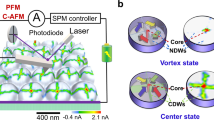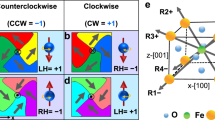Abstract
Topological defects in ferroic materials are attracting much attention both as a playground of unique physical phenomena and for potential applications in reconfigurable electronic devices. Here, we explore electronic transport at artificially created ferroelectric vortices in BiFeO3 thin films. The creation of one-dimensional conductive channels activated at voltages as low as 1 V is demonstrated. We study the electronic as well as the static and dynamic polarization structure of several topological defects using a combination of first-principles and phase-field modelling. The modelling predicts that the core structure can undergo a reversible transformation into a metastable twist structure, extending charged domain walls segments through the film thickness. The vortex core is therefore a dynamic conductor controlled by the coupled response of polarization and electron–mobile-vacancy subsystems with external bias. This controlled creation of conductive one-dimensional channels suggests a pathway for the design and implementation of integrated oxide electronic devices based on domain patterning.
This is a preview of subscription content, access via your institution
Access options
Subscribe to this journal
Receive 12 print issues and online access
$209.00 per year
only $17.42 per issue
Buy this article
- Purchase on Springer Link
- Instant access to full article PDF
Prices may be subject to local taxes which are calculated during checkout






Similar content being viewed by others
References
Mermin, N. D. Topological theory of defects in ordered media. Rev. Mod. Phys. 51, 591–648 (1979).
Tagantsev, A. K., Cross, L. E. & Fousek, J. Domains in Ferroelectric Crystals and Thin Films (Springer, 2010).
Blatter, G., Feigelman, M. V., Geshkenbein, V. B., Larkin, A. I. & Vinokur, V. M. Vortices in high-temperature superconductors. Rev. Mod. Phys. 66, 1125–1388 (1994).
Ran, Y., Zhang, Y. & Vishwanath, A. One-dimensional topologically protected modes in topological insulators with lattice dislocations. Nature Phys. 5, 298–303 (2009).
Salje, E. & Zhang, H. L. Domain boundary engineering. Phase Transit. 82, 452–469 (2009).
Sonin, E. B. & Tagantsev, A. K. Circulation lines and motion of antiphase walls in improper ferroelectrics. Zh. Éksp. Teor. Fiz 94, 315–328 (1988).
Tagantsev, A. K. & Sonin, E. B. Linear singularities and their motion in improper ferroelectrics. Ferroelectrics 98, 297–300 (1989).
Sonin, E. B. & Tagantsev, A. K. Structure and phase-transitions in antiphase boundaries of improper ferroelectrics. Ferroelectrics 98, 291–295 (1989).
Seidel, J. et al. Conduction at domain walls in oxide multiferroics. Nature Mater. 8, 229–234 (2009).
Kim, Y., Alexe, M. & Salje, E. K. H. Nanoscale properties of thin twin walls and surface layers in piezoelectric W O3−x . Appl. Phys. Lett. 96, 032904 (2010).
Tselev, A. et al. Mesoscopic metal–insulator transition at ferroelastic domain walls in VO2. ACS Nano 4, 4412–4419 (2010).
Daraktchiev, M., Catalan, G. & Scott, J. F. Landau theory of domain wall magnetoelectricity. Phys. Rev. B 81, 224118 (2010).
Salafranca, J., Yu, R. & Dagotto, E. Conducting Jahn–Teller domain walls in undoped manganites. Phys. Rev. B 81, 245122 (2010).
Goncalves-Ferreira, L., Redfern, S. A. T., Artacho, E., Salje, E. & Lee, W. T. Trapping of oxygen vacancies in the twin walls of perovskite. Phys. Rev. B 81, 024109 (2010).
Gruverman, A. et al. Vortex ferroelectric domains. J. Phys. Condens. Matter 20, 342201 (2008).
Rodriguez, B. J. et al. Vortex polarization states in nanoscale ferroelectric arrays. Nano Lett. 9, 1127–1131 (2009).
Ivry, Y., Chu, D. P., Scott, J. F. & Durkan, C. Flux closure vortexlike domain structures in ferroelectric thin films. Phys. Rev. Lett. 104, 207602 (2010).
McGilly, L. J., Schilling, A. & Gregg, J. M. Domain bundle boundaries in single crystal BaTiO3 lamellae: Searching for naturally forming dipole flux-closure/quadrupole chains. Nano Lett. 10, 4200–4205 (2010).
Wu, Z. et al. Unusual vortex structure in ultrathin Pb(Zr0.5Ti0.5)O3 films. J. Appl. Phys. 101, 014112 (2007).
Naumov, I. & Fu, H. Vortex-to-polarization phase transformation path in ferroelectric Pb(ZrTi)O3 nanoparticles. Phys. Rev. Lett. 98, 077603 (2007).
Slutsker, J., Artemev, A. & Roytburd, A. Phase-field modeling of domain structure of confined nanoferroelectrics. Phys. Rev. Lett. 100, 087602 (2008).
Prosandeev, S., Ponomareva, I., Naumov, I., Kornev, I. & Bellaiche, L. Original properties of dipole vortices in zero-dimensional ferroelectrics. J. Phys. Condens. Matter 20, 193201 (2008).
Wang, J. Switching mechanism of polarization vortex in single-crystal ferroelectric nanodots. Appl. Phys. Lett. 97, 192901 (2010).
Jia, C-L., Urban, K. W., Alexe, M., Hesse, D. & Vrejoiu, I. Direct observation of continuous electric dipole rotation in flux-closure domains in ferroelectric Pb(Zr,Ti)O3 . Science 331, 1420–1423 (2011).
Nelson, C. T. et al. Spontaneous vortex nanodomain arrays at ferroelectric heterointerfaces. Nano Lett. 11, 828–834 (2011).
McQuaid, R. G. P., McGilly, L. J., Sharma, P., Gruverman, A. & Gregg, J. M. Mesoscale flux-closure domain formation in single-crystal BaTiO3 . Nature Commun. 2, 404 (2011).
Balke, N. et al. Deterministic control of ferroelastic switching in multiferroic materials. Nature Nanotechnol. 4, 868–875 (2009).
Maksymovych, P. et al. Polarization control of electron tunneling into ferroelectric surfaces. Science 324, 1421–1425 (2009).
Jesse, S., Kalinin, S. V., Proksch, R., Baddorf, A. P. & Rodriguez, B. J. The band excitation method in scanning probe microscopy for rapid mapping of energy dissipation on the nanoscale. Nanotechnology 18, 435503 (2007).
Buhlmann, S., Colla, E. & Muralt, P. Polarization reversal due to charge injection in ferroelectric films. Phys. Rev. B 72, 214120 (2005).
Kholkin, A. L., Bdikin, I. K., Shvartsman, V. V. & Pertsev, N. A. Anomalous polarization inversion in ferroelectrics via scanning force microscopy. Nanotechnology 18, 095502 (2007).
Sichuga, D., Ren, W., Prosandeev, S. & Bellaiche, L. Chiral patterns of tilting of oxygen octahedra in zero-dimensional ferroelectrics and multiferroics: A first principle-based study. Phys. Rev. Lett. 104, 207603 (2010).
Neaton, J. B., Ederer, C., Waghmare, U. V., Spaldin, N. A. & Rabe, K. M. First-principles study of spontaneous polarization in multiferroic BiFeO3 . Phys. Rev. B 71, 014113 (2005).
Eliseev, E. A., Morozovska, A. N., Svechnikov, G. S., Gopalan, V. & Ya. Shur, V. Static conductivity of charged domain wall in uniaxial ferroelectric-semiconductors. Phys. Rev. B 83, 235313 (2011).
Catalan, G. & Scott, J. F. Physics and applications of bismuth ferrite. Adv. Mater. 21, 2463–2485 (2009).
Maksymovych, P. et al. Dynamic conductivity of ferroelectric domain walls in BiFeO3 . Nano Lett. 11, 1906–1912 (2011).
Farokhipoor, S. & Noheda, B. Conduction through 71° domain walls in BiFeO3 thin films. Phys. Rev. Lett. 107, 127601 (2011).
Biegalski, M. D., Doerr, K., Kim, D. H. & Christen, H. M. Applying uniform reversible strain to epitaxial oxide films. Appl. Phys. Lett. 96, 151905 (2010).
Rosenwaks, Y., Dahan, D., Molotskii, M. & Rosenman, G. Ferroelectric domain engineering using atomic force microscopy tip arrays in the domain breakdown regime. Appl. Phys. Lett. 86, 012909 (2005).
Cen, C., Thiel, S., Mannhart, J. & Levy, J. Oxide nanoelectronics on demand. Science 323, 1026–1030 (2009).
Martin, L. W. et al. Nanoscale control of exchange bias with BiFeO3 thin films. Nano Lett. 8, 2050–2055 (2008).
Zavaliche, F. et al. Ferroelectric domain structure in epitaxial BiFeO3 films. Appl. Phys. Lett. 87, 182912 (2005).
Zhang, J. X., Schlom, D. G., Chen, L. Q. & Eom, C. B. Tuning the remanent polarization of epitaxial ferroelectric thin films with strain. Appl. Phys. Lett. 95, 122904 (2009).
Kresse, G. & Furthmüller, J. Efficiency of ab-initio total energy calculations for metals and semiconductors using a plane-wave basis set. Comput. Mater. Sci. 6, 15–50 (1996).
Kornev, I., Lisenkov, S., Haumont, R., Dkhil, B. & Bellaiche, L. Finite-temperature properties of multiferroic BiFeO3 . Phys. Rev. Lett. 99, 227602 (2007).
Acknowledgements
Experiments were conducted at the Center for Nanophase Materials Sciences, which is sponsored at Oak Ridge National Laboratory by the Office of Basic Energy Sciences, US Department of Energy. Support was provided by the Division of Scientific User Facilities (N.B.) and by the Materials Sciences and Engineering Division (S.V.K.) of the US Department of Energy, Basic Energy Sciences. B.W., J.B. and L.Q.C. are supported by US Department of Energy, Basic Sciences, under Grant No. DE-FG02-07ER46417. L.B. thanks mostly support from the Department of Energy, Office of Basic Energy Sciences, under contract ER-46612. L.B. also thanks the National Science Foundation grants DMR-1066158 and DMR-0701558, and Office of Naval Research grants N00014-11-1-0384, N00014-08-1-0915 and N00014-07-1-0825. Some computations were also made possible thanks to the National Science Foundation grant 0722625 and a challenge grant from the US Department of Defense. Y.H.C. acknowledges the support of the National Science Council, Republic of China, under contract NSC-100-2811-M-009-003. M.H. acknowledges support by the Netherlands Organization for Scientific Research (NWO) through a VENI grant.
Author information
Authors and Affiliations
Contributions
N.B. and S.V.K. conceived and designed the experiments, and wrote the article. N.B. performed the experiments. B.W., J.B. and L.Q.C. performed phase-field modelling. W.R., L.B. and I.K. performed DFT calculations. A.N.M. and E.A.E. provided analytical theory for vortex structure and vacancy segregation. M.H., Y.H.C. and R.R. contributed materials and S.J. developed spectroscopic measurement technique and analysis tools. S.V.K., P.M. and R.K.V. co-wrote the article. All authors discussed the results and commented on the manuscript.
Corresponding authors
Ethics declarations
Competing interests
The authors declare no competing financial interests.
Supplementary information
Supplementary Information
Supplementary Information (PDF 838 kb)
Rights and permissions
About this article
Cite this article
Balke, N., Winchester, B., Ren, W. et al. Enhanced electric conductivity at ferroelectric vortex cores in BiFeO3. Nature Phys 8, 81–88 (2012). https://doi.org/10.1038/nphys2132
Received:
Accepted:
Published:
Issue Date:
DOI: https://doi.org/10.1038/nphys2132
This article is cited by
-
Ferroelectric solitons crafted in epitaxial bismuth ferrite superlattices
Nature Communications (2023)
-
The emergence of three-dimensional chiral domain walls in polar vortices
Nature Communications (2023)
-
Biferroelectricity of a homochiral organic molecule in both solid crystal and liquid crystal phases
Nature Communications (2022)
-
Giant switchable non thermally-activated conduction in 180° domain walls in tetragonal Pb(Zr,Ti)O3
Nature Communications (2022)
-
Electrically driven motion, destruction, and chirality change of polar vortices in oxide superlattices
Science China Physics, Mechanics & Astronomy (2022)



